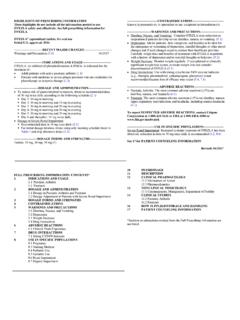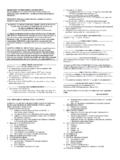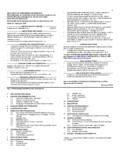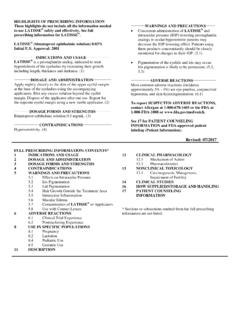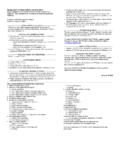Transcription of HIGHLIGHTS OF PRESCRIBING INFORMATION - …
1 HIGHLIGHTS OF PRESCRIBING INFORMATION Recommended initial dosage regimen for patients with renal These HIGHLIGHTS do not include all the INFORMATION needed to use impairment is shown in the table below. ( ). ZEMDRI safely and effectively. See full PRESCRIBING Recommended INFORMATION for ZEMDRI. Estimated CLcr a Dosage for ZEMDRI (plazomicin) injection, for intravenous use (mL/min) ZEMDRI b Dosing Interval Initial Approval: 2018 Greater than or equal to 60 15 mg/kg Every 24 hours WARNING: NEPHROTOXICITY, OTOTOXICITY, to less than 90. NEUROMUSCULAR BLOCKADE and FETAL HARM Greater than or equal to 30 10 mg/kg Every 24 hours See full PRESCRIBING INFORMATION for complete boxed warning. to less than 60. Nephrotoxicity has been reported with ZEMDRI. The risk Greater than or equal to 15 10 mg/kg Every 48 hours of nephrotoxicity is greater in patients with impaired renal to less than 30.
2 A CLcr estimated by the Cockcroft-Gault formula. ( ). function, the elderly, and in those receiving concomitant b Calculate dosage using Total Body Weight (TBW). For patients nephrotoxic medications. ( ). Ototoxicity, manifested as hearing loss, tinnitus, and/or with TBW greater than IBW by 25% or more, use adjusted body weight. ( ). vertigo, has been reported with ZEMDRI. Symptoms of aminoglycoside associated ototoxicity may be irreversible See Full PRESCRIBING INFORMATION for subsequent dosage and may not become evident until after completion of adjustment based on changes in renal function or Therapeutic therapy. ( ) Drug Monitoring (TDM). ( , ). Aminoglycosides have been associated with neuromuscular See Full PRESCRIBING INFORMATION for instructions on preparation blockade. During therapy with ZEMDRI, monitor for of the solution, stability in intravenous fluids and drug adverse reactions associated with neuromuscular blockade compatibilities.
3 ( , , ). particularly in high-risk patients. ( ) ---------------- DOSAGE FORMS AND STRENGTHS ---------------- Aminoglycosides, including ZEMDRI can cause fetal harm ZEMDRI injection 500 mg/10 mL (50 mg/mL) is a single-dose vial when administered to a pregnant woman. ( , ) containing plazomicin sulfate equivalent to 500 mg plazomicin free base. (3). ---------------------- INDICATIONS AND USAGE ---------------------- ZEMDRI is an aminoglycoside antibacterial indicated for the ------------------------- CONTRAINDICATIONS ------------------------- treatment of patients 18 years of age or older with Complicated ZEMDRI is contraindicated in patients with known hypersensitivity Urinary Tract Infections (cUTI) including Pyelonephritis. ( ) to any aminoglycoside (4, ). As only limited clinical safety and efficacy data are available, reserve ------------------ WARNINGS AND PRECAUTIONS ------------------ ZEMDRI for use in patients who have limited or no alternative Hypersensitivity Reactions, including anaphylaxis: Reported for treatment options.
4 ( ) aminoglycosides. If an allergic reaction occurs, discontinue ZEMDRI. ( ). To reduce the development of drug-resistant bacteria and maintain Clostridium difficile-Associated Diarrhea: Reported for nearly all effectiveness of ZEMDRI and other antibacterial drugs, ZEMDRI. systemic antibacterial drugs. Evaluate if diarrhea occurs. ( ). should be used only to treat infections that are proven or strongly suspected to be caused by susceptible microorganisms. ( ) ------------------------- ADVERSE REACTIONS ------------------------- Most common adverse reactions ( 1% of patients treated with ------------------DOSAGE AND ADMINISTRATION------------------ ZEMDRI) are decreased renal function, diarrhea, hypertension, Administer ZEMDRI 15 mg/kg every 24 hours by intravenous (IV). headache, nausea, vomiting and hypotension.
5 ( ). infusion over 30 minutes to patients 18 years of age or older with creatinine clearance greater than or equal to 90 mL/min. ( ) To report SUSPECTED ADVERSE REACTIONS, contact Recommended duration of treatment is 4 to 7 days for cUTI, Achaogen at 1-833-252-6402 or FDA at 1-800-FDA-1088 or including pyelonephritis. ( ) Assess creatinine clearance in all patients prior to initiating See 17 for PATIENT COUNSELING INFORMATION . therapy and daily during therapy. ( ). Revised: 6/2018. ZEMDRI PRESCRIBING INFORMATION 1. FULL PRESCRIBING INFORMATION : CONTENTS*. WARNING: NEPHROTOXICITY, OTOTOXICITY, 8. USE IN SPECIFIC POPULATIONS. NEUROMUSCULAR BLOCKADE and FETAL HARM Pregnancy 1. INDICATIONS AND USAGE Lactation Complicated Urinary Tract Infections (cUTI), Pediatric Use including Pyelonephritis Geriatric Use Usage Renal Impairment 2.
6 DOSAGE AND ADMINISTRATION 10. OVERDOSAGE. Recommended Dosage 11. DESCRIPTION. Monitoring of Renal Function 12. CLINICAL PHARMACOLOGY. Dosage in Adult Patients With Renal Impairment Mechanism of Action TDM in cUTI Patients With Renal Impairment Pharmacodynamics Preparation of Diluted Solutions of ZEMDRI Pharmacokinetics Stability of ZEMDRI Solution in Intravenous Microbiology Fluids 13. NONCLINICAL TOXICOLOGY. Drug Compatibility Carcinogenesis, Mutagenesis, and Impairment of 3. DOSAGE FORMS AND STRENGTHS Fertility 4. CONTRAINDICATIONS 14. CLINICAL STUDIES. 5. WARNINGS AND PRECAUTIONS Complicated Urinary Tract Infections, Including Nephrotoxicity Pyelonephritis Ototoxicity 15. REFERENCES. Neuromuscular Blockade 16. HOW SUPPLIED/STORAGE AND HANDLING. Fetal Harm How Supplied Hypersensitivity Reactions Storage and Handling Clostridium difficile-Associated Diarrhea 17.
7 PATIENT COUNSELING INFORMATION . Development of Drug-Resistant Bacteria 6. ADVERSE REACTIONS *Sections or subsections omitted from the full PRESCRIBING Clinical Trial Experience INFORMATION are not listed. ZEMDRI PRESCRIBING INFORMATION 2. FULL PRESCRIBING INFORMATION . WARNING: NEPHROTOXICITY, OTOTOXICITY, NEUROMUSCULAR BLOCKADE and FETAL HARM. Nephrotoxicity has been reported with ZEMDRI. The risk of nephrotoxicity is greater in patients with impaired renal function, the elderly, and in those receiving concomitant nephrotoxic medications. Assess creatinine clearance in all patients prior to initiating therapy and daily during therapy [see Dosage and Administration ( ) and Warnings and Precautions ( )]. Therapeutic Drug Monitoring (TDM) is recommended for complicated urinary tract infection (cUTI) patients with CLcr less than 90 mL/min to avoid potentially toxic levels [see Dosage and Administration ( , )].
8 Ototoxicity, manifested as hearing loss, tinnitus, and/or vertigo, has been reported with ZEMDRI. Symptoms of aminoglycoside-associated ototoxicity may be irreversible and may not become evident until after completion of therapy. Aminoglycoside-associated ototoxicity has been observed primarily in patients with a family history of hearing loss, patients with renal impairment, and in patients receiving higher doses and/or longer durations of therapy than recommended [see Warnings and Precautions ( )]. Aminoglycosides have been associated with neuromuscular blockade. During therapy with ZEMDRI, monitor for adverse reactions associated with neuromuscular blockade, particularly in high-risk patients, such as patients with underlying neuromuscular disorders (including myasthenia gravis) or in patients concomitantly receiving neuromuscular blocking agents [see Warning and Precautions ( )].
9 Aminoglycosides, including ZEMDRI, can cause fetal harm when administered to a pregnant woman [see Warnings and Precautions ( ), Use in Specific Populations ( )]. ZEMDRI PRESCRIBING INFORMATION 3. 1. INDICATIONS AND USAGE. Complicated Urinary Tract Infections (cUTI), including Pyelonephritis ZEMDRI is indicated in patients 18 years of age or older for the treatment of complicated urinary tract infections (cUTI), including pyelonephritis caused by the following susceptible microorganism(s): Escherichia coli, Klebsiella pneumoniae, Proteus mirabilis, and Enterobacter cloacae. As only limited clinical safety and efficacy data for ZEMDRI are currently available, reserve ZEMDRI for use in cUTI patients who have limited or no alternative treatment options [see Clinical Studies ( )]. Usage To reduce the development of drug-resistant bacteria and maintain the effectiveness of ZEMDRI.
10 And other antibacterial drugs, ZEMDRI should be used only to treat or prevent infections that are proven or strongly suspected to be caused by susceptible bacteria. When culture and susceptibility INFORMATION are available, they should be considered in selecting or modifying antibacterial therapy. In the absence of such data, local epidemiology and susceptibility patterns may contribute to the empiric selection of therapy. 2. DOSAGE AND ADMINISTRATION. Recommended Dosage The recommended dosage regimen of ZEMDRI is 15 mg/kg administered every 24 hours by intravenous (IV) infusion over 30 minutes in patients 18 years of age or older and with creatinine clearance (CLcr) greater than or equal to 90 mL/min (Table 1). The duration of therapy should be guided by the severity of infection and the patient's clinical status for up to 7 days.
